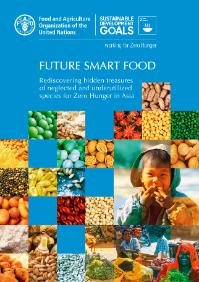Future smart food: rediscovering hidden treasures of neglected and underutilized species for zero hunger in Asia
 For centuries people in Asia and the Pacific region have grown and consumed a wide variety of nutritious foods. Unfortunately, more recent generations have slowly but surely changed their diets and have moved away from many of these traditional foods. The Food and Agriculture Organization of the United Nations (FAO) is working with our Member Countries to reinvigorate both production and consumption of these crops – often referred to as neglected and underutilized species (NUS). This work is consistent with FAO’s role in providing support to countries to meet the targets of the Sustainable Development Goals (SDGs), primarily, but not limited to, SDG2 which aims to achieve Zero Hunger, specifically to “end hunger, achieve food security and improved nutrition, and promote sustainable agriculture” by 2030. The Zero Hunger goal implies that no one should be left behind. The Asia-Pacific region is home to most of the world’s undernourished people (490 million). Other forms of malnutrition remain challenging, including stunting and micronutrient deficiencies. While in some countries there are rising rates of overweight and obesity. The issues are manifest in both the demand side and supply side. On the demand side, there is population growth, urbanization, migration, and the changing consumption associated with rising incomes. On the supply side, the combined effects of climate change, declining agricultural biodiversity, water scarcity, land scarcity, and degradation of natural resources are threatening world food security.
For centuries people in Asia and the Pacific region have grown and consumed a wide variety of nutritious foods. Unfortunately, more recent generations have slowly but surely changed their diets and have moved away from many of these traditional foods. The Food and Agriculture Organization of the United Nations (FAO) is working with our Member Countries to reinvigorate both production and consumption of these crops – often referred to as neglected and underutilized species (NUS). This work is consistent with FAO’s role in providing support to countries to meet the targets of the Sustainable Development Goals (SDGs), primarily, but not limited to, SDG2 which aims to achieve Zero Hunger, specifically to “end hunger, achieve food security and improved nutrition, and promote sustainable agriculture” by 2030. The Zero Hunger goal implies that no one should be left behind. The Asia-Pacific region is home to most of the world’s undernourished people (490 million). Other forms of malnutrition remain challenging, including stunting and micronutrient deficiencies. While in some countries there are rising rates of overweight and obesity. The issues are manifest in both the demand side and supply side. On the demand side, there is population growth, urbanization, migration, and the changing consumption associated with rising incomes. On the supply side, the combined effects of climate change, declining agricultural biodiversity, water scarcity, land scarcity, and degradation of natural resources are threatening world food security.
